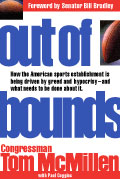Collegiate Athletics in 2031 — Division I Dystopia?
BY TOM MCMILLEN
4.12.2021
President Smith, the first female president of the NCAA, announced on the eve of the NCAA basketball tournament that the strike between the players and the NCAA had been settled – with the concession that in the future, football players and men’s and women’s basketball players will receive 30% of overall sports revenue instead of the 20% previously legislatively mandated. That earlier revenue-sharing bill had been passed by Congress in 2025 after numerous state legislatures approved such legislation. As a result, grant-in-aid scholarships have largely been eliminated for basketball and football programs because the players have been earning in excess of $100,000 per year from revenue sharing. |
Later in the year we are likely to see Title IX advocates finally win their challenge against the revenue-sharing model established in 2025. The courts are expected to rule that the legislation’s mandated revenue distributions to men only were inequitable and, in the future, under the expected ruling, female athletes would share equally in all football and men’s basketball revenue. This ruling is apt to cause considerable friction between the men and women if the men feel that the “profits off their labor” are now unfairly apportioned to women.
The past decade saw the term “student athlete” disappear as graduation rates plummeted for college athletes because most college football and basketball players sought to maximize their earning power, and time involved in practice, games, travel, and making money off their name, image and likeness resulted in athletes only sporadically fulfilling their academic responsibilities, and mostly online.
The Alston case, affirmed by the Supreme Court in 2021, has led to a new arms race to provide “unlimited educational expenses” to college athletes. The Southeastern Conference, in 2022, was the first to approve a $25,000 postgraduate internship job for all basketball and football players. Other conferences followed suit, and a plethora of new benefits have been extended to college athletes, including luxury study abroad programs and the latest education technology, with expenses for these programs skyrocketing each year.
Lavish sportsbooks have opened in many campus stadiums and arenas to attract new fans and provide easy access to sports betting. But the ability to easily bet on games has created intense and sometimes dangerous reactions among fans. Over the past several years, when teams have lost, the social media attacks on players have become so intense that this year round-the-clock security will be provided for many college athletes. Despite these dangers, sports betting has exploded, and real-time sports data from live college events sold to gambling companies have become a growing profit center for athletic programs. These data sales have begun to rival television revenue as a cash cow for university sports programs.
Philanthropy, institutional support, and student fees, which once represented more than $3 billion in annual support for athletic departments, have all but disappeared — donors and college administrators do not want to support these commercial enterprises. Students, especially, do not want to pay massive activity fees to support sports they cannot participate in. These teams, in students’ eyes, are professional in all but name.
When the revenue shortfalls and money required to be allocated to players, most colleges have been forced to eliminate nonrevenue sports like golf, volleyball and softball. The NCAA has stopped requiring institutions to sponsor a minimum number of sports. As a result, thousands of scholarships for student athletes in those sports have been eliminated. This change has hit men’s sports especially hard since Title IX provides some protection for women’s sports. In turns, the U. S. Olympic effort has been severely weakened, because many of the athletes who traditionally participated in the international games from from college athletic programs.
Television viewership for college sports has declined five years in a row—many fans alumni are turned off by the growing commercialism. Among these disenchanted fans are the wealthiest and most educated Americans and men over 50, the same demographics most likely to have watched in prior years.
When revenue-sharing laws were enacted in 2025, the IRS challenged the long-standing charitable status of college sports, reclassified college athletes as employees, and began to tax television and corporate sponsorship revenue, putting additional pressures on stretched athletic department budgets.
Recently the Knight Commission, the watchdog for college sports for more than 40 years, has called for a Presidential Commission on Intercollegiate Athletic to try to restore some sense of proportion to college sports and the higher educations values supposedly underlying them.
Historians conclude that the connection of college sports to the goals of higher education began to fray long before the court rulings and legislative actions in the 2020s. The arms race then — and accelerating salaries for coaches and spending on facilities — was only intensified by the subsequents race to recruit and compensate college athletes through more and more benefits. Professionalism is now deeply ingrained in our college sports programs and has hit hard the academic credibility of many institutions. The sad fact is that college sports will never against by in sync with the mission of higher education.
Tom McMillen in CO of LEAD1 Associations, a former member of Congress, and a former member of the Knight Commission.









